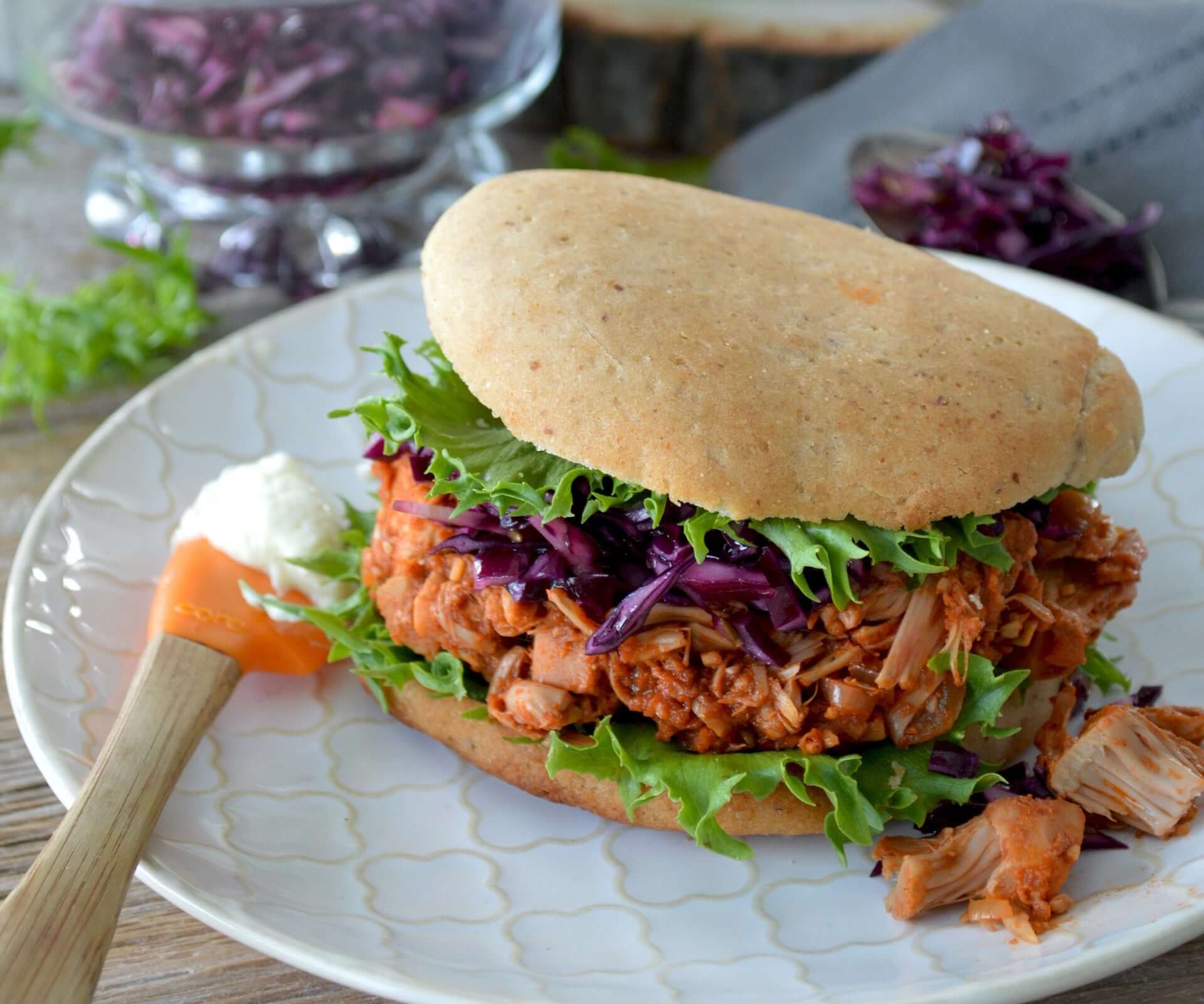
Inhaltsverzeichnis
Natural meat replacement products that you should know
Processed meat substitutes based on soy, wheat, or pea protein are certainly good and definitely have their place. But are there natural products that come close to the taste or texture of meat? The answer is "yes"! I'd like to introduce you to three of these natural substitutes today.
1. King oyster mushrooms
Mushrooms as a meat substitute? Yes, indeed! One type of mushroom is particularly suitable as a natural alternative to meat: king oyster mushrooms. I first stumbled upon them in an English recipe. Here, the mushrooms are called "king oyster mushrooms." In German, they also use the term "King oyster mushroom”. In fact, king oyster mushrooms are closely related to oyster mushrooms.
The king oyster mushroom is often mentioned as an alternative to the rare porcini mushroom. Due to its firm consistency, this mushroom variety, when prepared, is reminiscent of chicken meat. Nevertheless, the king oyster mushroom has a spicy-nutty aroma, so it is not as tasteless as the other natural meat substitutes presented here.

Photo by Megumi Nachev on Unsplash
The mushroom species is available all year round at the same price, as it exclusively from farmed crops Because cultivating king oyster mushrooms is particularly labor-intensive and requires constant monitoring, these mushrooms are more expensive than other cultivated mushrooms. If you can't find them in conventional supermarkets, you can look for this variety in organic and Asian stores.
Nutrients and preparation
It is not surprising that king oyster mushrooms are low in calories. What is not necessarily expected is that 100g of mushroom contains 4g protein In addition, oyster mushrooms contain B vitamins and plenty Fiber. In addition, they are virtually fat-freeSome growers use fungicides and insecticides – if you want to avoid such substances, you should therefore pay attention to Organic farming regard.
A “good” king oyster mushroom should look plump, juicy, and not too dry. If they are still freshThey taste best when they're fresh. King oyster mushrooms can also be frozen (cleaned and sliced) and will keep in the freezer for up to 8 months.
The stems can be used, but dry stem ends should be removed before processing. Like other mushrooms, king oyster mushrooms are very versatile and can be used in mushroom stir-fries, vegetable dishes, risottos, or soups.
The meat-like consistency is best obtained by cutting the mushrooms into strips and frying them in a little oil fry in the panSeasoned with a little pepper and salt, they make a perfect side dish for all sorts of dishes. My personal favorite is king oyster mushrooms in a sauce with pasta. Definitely give it a try!
2. Jackfruit
A real insider tip for people who follow a vegetarian or vegan diet. Okay, I admit, jackfruit is more well-known than secret these days. Nevertheless, I'm still surprised at how few of us have tried it. Jackfruit is the kind of substitute that, after proper preparation, meat eaters can usually not notice that it is not meatwhat they eat there.
But what exactly is a jackfruit?
The jackfruit is, as the name suggests, a fruit that grows on trees in the tropical regions of the earth The trees grow up to 20 meters tall and bear up to 700 fruits per year. What makes them special is that the jackfruit is the heaviest and largest tree fruit in the worldThe fruits can weigh 40-50 kg and are approximately 1 meter long. A fruit consists of a kernel, seeds, pulp surrounded by fibrous strands, and a hard, rubbery shell with a kind of nub. Depending on ripeness, the fruit has a yellow or greenish-brown color.

In its native regions, jackfruit is often eaten ripe. It then has a sweet taste reminiscent of a mix of banana and pineapple. To serve as a meat substitute, the unripe flesh is used. pickled in brine and processed further.
Buying, preparing and eating jackfruit
In our latitudes, jackfruit is rarely sold whole, but usually (preserved in brine) in cans or jars. It is available in organic and Asian supermarkets, but increasingly also in major supermarket chains. A can costs between 2 and 5 euros.
The immature Pulp is almost tasteless Its consistency is very similar to chicken, especially due to its fibrous texture and the crust that forms when roasted. It can be marinated Whether diced, striped, or pulled (see cover image), jackfruit can be easily prepared at home as a meat substitute.
In terms of nutrients, jackfruit is reminiscent of a Potato, because, among other things, it contains quite a lot of starch. It's low in fat and doesn't contain much protein, but it's rich in calcium.
The ecological balance of jackfruit
As mentioned at the beginning, jackfruit comes from the tropics. The main growing countries are India, Thailand, Bangladesh, Sri Lanka, and Indonesia. That's a long way away. And that's precisely where the catch lies: By the time the jackfruit reaches us, it has already consumed a considerable amount of fossil fuels and produced a considerable CO2 footprint.
When buying, you should also pay attention to Organic quality The mixed crops of organic farmers are significantly more sustainable than the monocultures of “conventional” farmers. You can find organic jackfruit at, among others, Jacky F., Govinda and June's.
Jackfruit is fine to eat every now and then, but you should always keep in mind the fruit's rather questionable ecological footprint.
3. Tempeh
Okay, strictly speaking, that's a bit of a cheat. Tempeh isn't a "direct" food that grows in the field or falls from a tree. Nevertheless, it's natural and consists of only two components: Soybeans and the Noble mold Rhizopus oligosporus. It can also be made from chickpeas, peanuts, or lupine instead of soybeans, but this form is less common. If you like, you can even make tempeh at home.
The soybeans are enriched with the mold and then fermented. It creates a quite solid structure with a grainy consistency. Tempeh has a fairly neutral taste and is therefore usually eaten marinated. This meat substitute can be used in many ways: grilled, baked in the oven, or pan-fried. It is usually cut into thin slices. Burger patty, Schnitzel substitute or Side dish served. If you crumble it lightly, the consistency is somewhat reminiscent of minced meat.
Nutrients and sustainability
Like other soy products, tempeh is rich in protein and contains even more protein than tofu. Fermentation allows our bodies to absorb this protein particularly well. Tempeh is also rich in Fiber and mineralsUnlike meat, it contains no cholesterolThe “natural” meat substitute is gluten-free and low in fat and calories. The plant hormones contained in tempeh can, if consumed very frequently, disrupt the hormonal balance. Cancer patients should consult their doctor.
Tempeh originally comes from Asia. Conventionally grown soybeans there may be genetically modified. Therefore, when purchasing tempeh, it is important to be aware of Organic quality If you want to kill two birds with one stone, buy Tempeh from Germany or Austria: Genetically modified soybeans are not permitted in Europe and regional cultivation significantly shortens transport routes, which saves CO2.
Buy and prepare tempeh
This soy product is usually found in vacuum-packed, sausage-like pieces in the refrigerated section of health food stores and organic shops. In addition to the plain version, there is also smoked tempeh or, more rarely, seasoned or marinated tempeh.
The preparation is very uncomplicatedIt is cut into pieces or “crumbled” and then marinated or seasoned, z.B with soy sauce, sriracha, paprika, tomato paste, vinegar, or maple syrup. As already mentioned, tempeh can be fried, baked, or grilled, depending on your preference.

Photo by Ella Olsson on Unsplash
If you would like to learn more about healthy eating, mindfulness or sustainability, take a look here over.



























Leave a comment
This site is protected by hCaptcha and the hCaptcha Privacy Policy and Terms of Service apply.